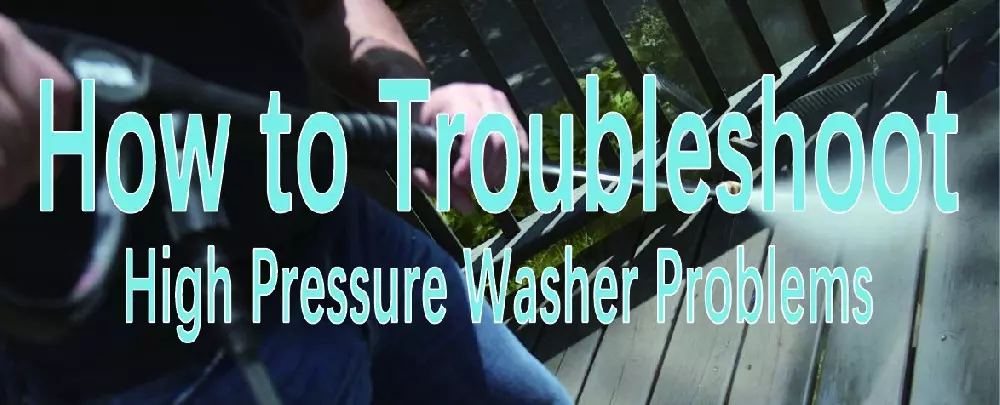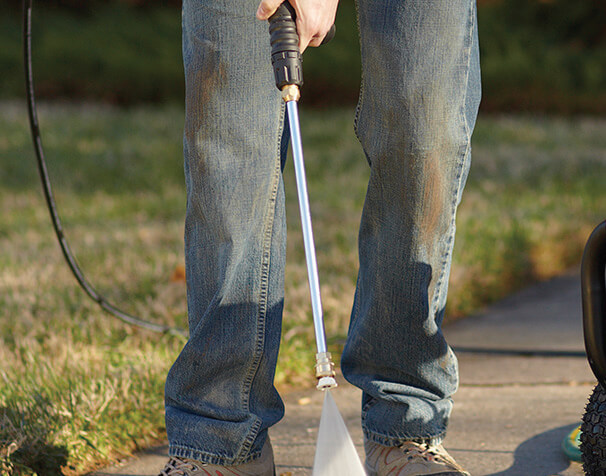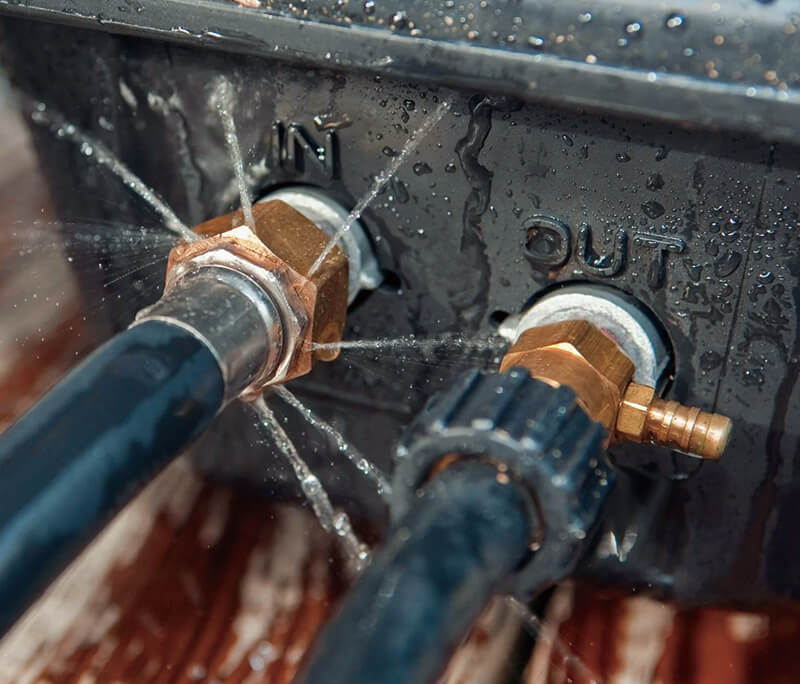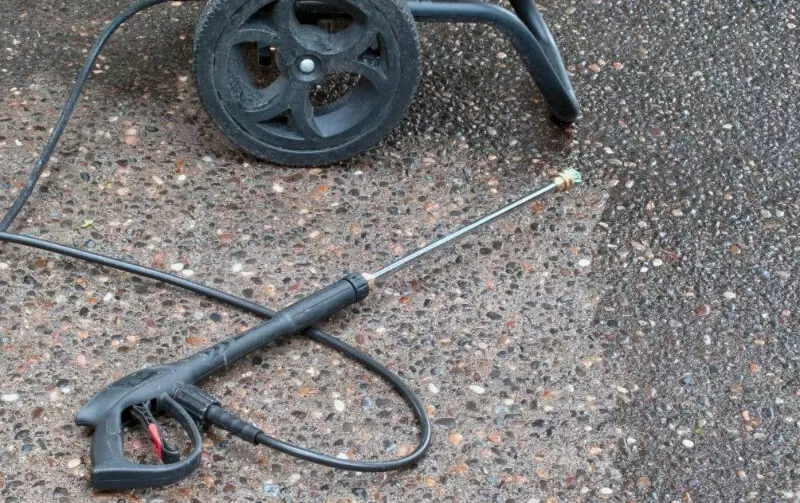11Mar 2023
table of contents

High pressure washers are great tools, and a good one can drastically reduce the effort and time spent cleaning decks, cars, siding, farm equipment, and more. Like all machines, pressure washers break down from time to time, and these failures can take many forms, from engine problems, pump or rod problems, to water pressure problems, leaks, and more, read on to learn about the most common failure modes for these machines, and How to repair them. The BISON troubleshooting guide will help you get your machine working fine again.
Let's start by looking at some of the problems you may have with a gasoline pressure washer.
No petrol,check the petrol level on the high pressure washer. If there is no gas or not enough petrol, please top it up.
Wrong choke position,check the owner's manual provided by the manufacturer and move the choke to the recommended position.
Increased pressure,pressure may build up in your petrol pressure washer, squeeze the trigger gun to release the built-up pressure in the system.
Disconnect the spark plug wire,if your spark plug wire gets disconnected, just reconnect it and the pressure washer will start.
Spark plug failure,you may have a faulty spark plug, which is responsible for providing the spark that starts the engine, and if dirty or damaged, it could cause the engine to fail to start or lose power. To check if the spark plugs are the cause of the problem, remove them and check for any signs of wear or damage. If the spark plugs are dirty or damaged, they need to be replaced.
Maybe you started your pressure washer, but it stopped while you were using it. BISON has some simple fixes for engine not running issues:
Low oil level, this could be due to low oil. Most petrol pressure washers automatically shut off when the oil level gets too low. Make sure to check the oil level and top up if necessary.
Carburetor clogged, if the engine won't run after a long period of inactivity, and you know it's sparking and has enough oil, the carburetor is most likely stuck with old fuel. Try opening the carburetor drain plug and letting a small amount of old fuel drip out.
Dirty air filter,the air filter keeps debris and dust out of the engine. When the air filter becomes clogged, it can restrict airflow and cause the engine to lose power or not start at all. If your air filter is clogged with dust, try cleaning it out. If that doesn't work, replace with a new air filter and try again.
Seal wear,If the engine is leaking oil, it is mainly due to worn seals. It's time to replace the seals. Please consult the manufacturer of high pressure cleaning - BISON.
Let’s take a look at some of the problems that come with electric pressure washers and how to fix them.
If your electric pressure washer won't start at all, BISON offers some quick and easy fixes:
Power outlet failure, the power outlet may not be working properly. Check main fuses and check plugs. If there is a problem with that outlet, call an electrician and use a different outlet at the same time.
Pressure washer not plugged in, we've all been there...why isn't our device working? Oh, we forgot to plug it in! DMake sure your pressure washer is plugged in properly. Your fix might be as simple as that.
Check reset switch, some electric pressure washers have a reset switch that you need to press after plugging in the pressure washer. This is required to start the pressure washer.
Motor failure, it could be a bigger problem, like a motor failure. If you find that nothing else works, please contact your manufacturer and have it replaced under warranty.
If the motor stops during use, the voltage may be too low. You have to check that the voltage is within the specified range for the motor. If changing it doesn't help, check with the electric pressure washer manufacturer to see if they have any suggestions, or if there could be a motor failure.

If the high pressure washer has no pressure, two problems may be to blame:
Damaged unloading valve, If the unloading valve is damaged or worn, adjust the unloading screw and check whether the seal or spring is damaged and replace if necessary.
Damaged pump inlet valve or manifold,If your pump inlet valve or manifold is damaged, disassemble the pump and replace or clean the components of the inlet manifold.
Low water pressure is also a problem, which is caused by various factors according to BISON's years of manufacturing experience.
Insufficient water supply, you may not be getting enough water. Check that your hoses are not kinked, then make sure you have adequate water pressure at your faucets. Also, check your pressure washer manual to check that you are using the correct diameter garden hose.
Inlet filter clogged, check your garden hose connections for clogs. Start isolating the problem by connecting the water hose to the inlet of the pressure washer and turning it on. You know the water is circulating if water comes out of the outlet. If not, your inlet water filter may be clogged, remove it and clean it!
Using the wrong nozzle, proper nozzle may not be used.But before confirming that you are using the correct nozzle, check the nozzle for clogging, remove it from the gun and remove any debris that may be clogging the opening.
Inlet chemical injector valve open, If you leave the chemical injector valve open and there is no detergent in the detergent collection tube then it will draw air into the detergent line causing low water pressure, put the tube in detergent or close the injector valve.
Pump manifold seal leaks, If your pump manifold seals are leaking, it could be causing low pressure. You should replace the seals for better water pressure.
In addition to low or no pressure, you may also find that your pressure washer has pulsating pressure. Let's see the best way to solve this problem:
Damaged pump inlet valve or manifold, similar to the problem of no water pressure, this problem can also cause pulsating pressure. Disassemble the pump, replace or clean parts of its inlet manifold, and reassemble.
Pump failure, the pump may be faulty, in which case BISON thinks you can only replace it early. If still under warranty, please contact the manufacturer.
pump sucks air, If the pump is drawing air, turn off the machine but leave the water on. Relieve the pressure by squeezing the trigger gun, check the water pressure again when you're done, and that should fix the problem.
Presence of obstruction causing pulsating pressure, in the case of a clogged nozzle, you should use a needle to clear the hole. It could also be that the water inlet filter is clogged. In this case, rinse the water inlet with clean water. Finally, there may be a clogged spray gun or wand, remove any deposits.

There's nothing more annoying than a leaky pressure washer creating a mess and resulting in low PSI. But you can try to troubleshoot and fix a leaking pressure washer with the following simple repairs that BISON mentions.
Break the seal, If the pump leaks, the seals may be cracked, damaged or worn. In this case, you will need to replace the seal or the entire pressure washer.
Loose pump assembly bolts, Check your pump assembly and tighten the bolts to make sure the pump casings are properly sealed together.
Thermal valve activation, A defective heat release valve can also cause the pump to leak. This valve allows heated, pressurized water to flow from the pump if the pressure washer is run for too long without pulling the trigger. If the thermal relief valve keeps leaking, it is defective and needs to be replaced.
Leaking hose connection, connection problem, the connection may be broken or incorrect. Check if this is the problem and connect properly to fix the problem.
Hose is punctured or torn, hoses wear out over time and need to be replaced frequently. To prevent this from happening in the future, try to keep the hose off the ground so it doesn't kink or pinch the device, especially while in use.
Broken rubber gasket, If the rubber gaskets are broken or worn, they will be responsible for keeping water from leaking out of the hose, gun or pump. Replace it if they are damaged or worn, causing water leaks and reducing the overall pressure and efficiency of the machine.
Lance or nozzle connections are leaking, the bottom end of the lance where the hose is attached is another common leak point. A leak in there will not only cause a pressure drop, but also wet your arms and sleeves. Let's see how to prevent water from leaking from the lance or spray connection. Loosen the screws that hold the stick assembly together, making sure to put them in a safe place. Carefully examine the inner workings of components under bright light. If any cracks are found, the entire lance will need to be replaced.
Damaged o-ring, If none of the above, check the O-ring inside the hose fitting for damage. Please replace the O-ring or replace with a new hose.
BISON can provide replacement parts for high-pressure cleaners, welcome to consult and purchase!
While BISON mentions many common problems experienced by pressure washer users, there are many others you may encounter. Read on for solutions below so you can enjoy pressure washing without any problems!
Detergent spray doesn't work, let's look at the specific cause and the appropriate fix:
Wrong nozzle, this can cause problems if you use the wrong nozzle.
Soap inlet valve clogged, the soap inlet valve may be clogged. This is on the pump side of the tube, to secure it, remove the hose and use a small allen wrench through the hole and clear debris or loosen the ball valve.
Concentrated detergent, the detergent mixture may be too thick, especially if it wasn't diluted enough. Adding more water to the solution can increase its effectiveness.
Insufficient supply of detergent, check that there is enough detergent in the supply container. The tubing needs to be fully submerged to allow most of the cleaning solution to pass through.
High pressure washer is too noisy.
No one, least of all your neighbors, doesn't want to deal with a noisy pressure washer. In response to this situation, BISON believes that there are the following situations:
If the water inlet is blocked, it may cause excessive noise. Check for blockage, clean or replace water inlet.
There may not be enough oil in the engine or pump. If it's an engine, just add oil. If the problem is with the water pump, it must be disassembled for inspection and filled according to the manufacturer's instructions.
Pump oil leak, leakage of the pump will bring great potential safety hazards, attention should be paid to:
It could just be that the mounting bolts are loose, so tighten them up.
Damaged parts, components such as pistons or seals may be damaged. Thoroughly inspect for damage, which may require disassembling parts, cleaning parts that need cleaning, or replacing damaged parts.
Pressure washer pump overheating, let's see what to do if your pump overheats.
While a thermal safety valve prevents overheating, it can sometimes have the opposite effect. If you never turn it off, water can stagnate in the washer, preventing fresh cold water from getting in.
You should pull the trigger every minute or so to release the water. If you are not using your BISON pressure washer for a while, do not leave the washer running as this can overheat the pump and cause permanent damage.
The pressure washer pump is making strange noises and no water flow
If you start your pressure washer and it runs fine, but no water comes out and you hear the water pump making strange noises, you may have made a serious and common mistake last season.
In cold winter climates, your pressure washer needs to be completely drained and it is best to top up with antifreeze before winter storage. Forget to do this and you will almost certainly leave water in the machine's pump. When winter comes, the water can freeze, expand and severely damage the internal structure of the pump.
When this happens, your only option is to replace the pump. You can find videos online that guide you through the replacement installation, or call a professional, or contact the BISON professional washer team.
High pressure washer runs but does not spray
What to do if your pressure washer is running but not spraying? There are several reasons:
You may have shut off the water supply, just turn on the water supply valve.
Clean pressure nozzle to remove blockage. If this doesn't work, you may need to replace the nozzle.
Some high-end pressure washers come with a built-in container of special pressure washer fluid soap. The idea is that mixing soap with a pressurized water spray will help clean items better and faster. Some BISON pressure washers also have this feature, and it can make a big difference when you have a lot of caked-on grime to deal with.
The problem is, the soap usually doesn't flow properly from the container, even when it's full. Nine times out of ten, the reason is simple: Excessive back pressure in the pump will prevent the soap from being drawn into the nozzle. But it can't pick up the soap properly, try removing the nozzle.

Trigger gun won't shut off
This can lead to some frustrating issues if your trigger gun won't shut off. BISON will share some possible fixes:
Debris in valve assembly, there may be debris in the gun's valve assembly. In this case, clean the valve assembly as much as possible. If not, the trigger gun needs to be replaced.
Worn or missing o-rings, If you're using a quick connect fitting, check the coupler between the trigger gun and the hose connection. Here you will find the location of the O-ring. If lost or it wears out, it's time to replace it, too.
High pressure cleaner emits black smoke for a long time
This is a pretty serious problem. If there is white or black smoke, you'll want to deal with it right away.
Wrong fuel, you may be using the wrong type of fuel, or you may have accidentally added water to the fuel tank. Please empty the fuel tank and refill with the correct type of fuel.
Improper air conditioning, provide the correct fuel to air ratio by adjusting the air strip on the burner assembly.
WARNING: BISON recommends replacing the coil insulation prior to this. Unused fuel can saturate insulation and can start a fire in the heating coil combustion chamber. Please feel free to contact us with any questions or concerns, we'll be happy to advise or help!
Low fuel pressure can lead to smoking, especially in hot water pressure washers since they require fuel pressure over 140 PSI for the burner to operate properly. Consult the owner's manual and adjust the fuel pump pressure to the correct specification.
Soot may accumulate on the coil. Clean them with a fume extractor or contact a local service agency to clean them for you.
Our complete guide to pressure washer troubleshooting should point you in the right direction on what's holding you back from achieving your cleaning goals. We hope you now feel more confident troubleshooting your pressure washer and getting it back up and running quickly. If you still have questions or would like the experts at BISON to advise you on your problem, please do not hesitate to contact us, We're here to help you with any repair issues you may have. Whether you are a business owner with ongoing cleaning needs, or are considering starting a pressure washing business, don't hesitate to get in touch!
inquiry form here
BISON BLOG, All the latest news and views from Bison Machinery.
Related Articles
why does your pressure washer have surging or pulsing how to use soap on a pressure washer when to repair or replace pressure washer pump can you run a pressure washer without water why pressure washer won’t startRelated Products